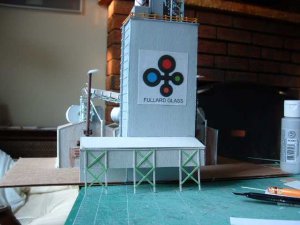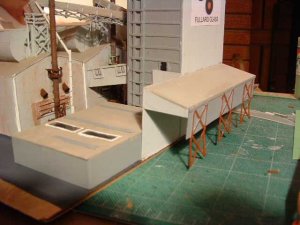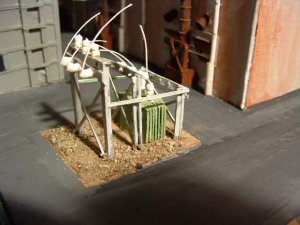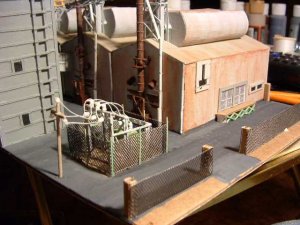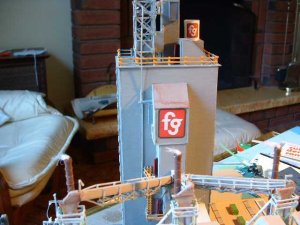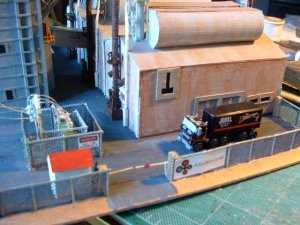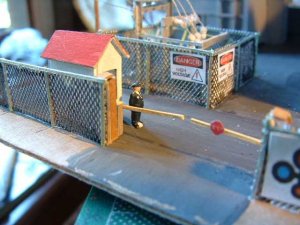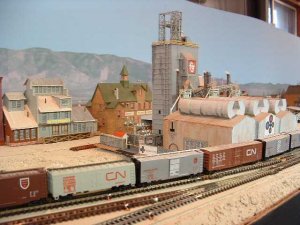Val is very talented and designed a fantastic logo for the glass factory. I hope she earns good profit from this business as well as giving the MAT some good business too. You can see the logo on the wall of the tower and also see where I am building the unloading dock.
About the logo
The blue circle is sand(silica) the orange circle is soda ash(sodium carbonate) the green circle is limestone(calcium carbonate) and the red circle is heat, as it takes tremandous heat to melt the three elements that make up the glass.
Here is some info about glass making.
No other kind of factory looks like a glass plant. Huge bins called silos hold the raw materials for glassmaking. These materials are powders that look much alike but can produce greatly different results. Giant roof ventilators and huge stacks release the terrific heat required to melt these powders to a white-hot liquid. At the hot end of the plant are the furnaces.
Mixing. The principal raw materials come to the glass plant in railroad cars and are stored in large silos. The materials are carefully weighed and mechanically mixed in the proper proportions. The mix of ingredients is called the batch. The manufacturer then adds cullet to the batch. Cullet is either recycled glass or waste glass from a previous melt of the same kind of glass. Adding cullet to the batch uses materials that otherwise would be wasted. It also reduces the amount of heat needed to melt the new batch of raw materials. Sometimes, glassmakers produce a new batch entirely from cullet. After mixing, the batch goes to the furnaces in batch cars, in hoppers, or on conveyor belts.
Melting. The mixture melts at 2600 to 2900 °F (1425 to 1600 °C), depending on its composition. In early times, the batch was melted in refractory pots (small clay pots) that were generally heated by wood fires. Special refractory pots today hold up to 3,000 pounds (1,400 kilograms) of glass. They are heated by gas or oil, and a single furnace may contain 6 to 12 pots. Small quantities of optical glass, art glass, and specialty glass still are made in refractory pots.
Larger quantities of glass are made in furnaces that are called day tanks because the process that goes on in them takes about 24 hours. The day tank is filled with raw materials, the glass is melted, and all the glass is used before the furnace is filled again. Day tanks can hold 1 to 4 tons (0.9 to 3.6 metric tons) of glass.
Most glass is melted in large furnaces called continuous tanks. The largest continuous tanks can melt 400 to 600 tons (360 to 540 metric tons) a day for production of flat glass. From 50 to 300 tons (45 to 270 metric tons) of container glass can be melted daily. Smaller continuous tanks are used to produce most other glass products. The operation is continuous. Raw materials are fed into the loading end as rapidly as molten glass is removed from the working end. Loading, melting, and working go on from when the fires are first lighted until they are extinguished at the end of a period called a campaign. A campaign may last as long as 10 years. The length of a campaign is almost always determined by the time it takes the refractory brick walls of the furnace to wear out from the constant heat and friction of the glass.
About the logo
The blue circle is sand(silica) the orange circle is soda ash(sodium carbonate) the green circle is limestone(calcium carbonate) and the red circle is heat, as it takes tremandous heat to melt the three elements that make up the glass.
Here is some info about glass making.
No other kind of factory looks like a glass plant. Huge bins called silos hold the raw materials for glassmaking. These materials are powders that look much alike but can produce greatly different results. Giant roof ventilators and huge stacks release the terrific heat required to melt these powders to a white-hot liquid. At the hot end of the plant are the furnaces.
Mixing. The principal raw materials come to the glass plant in railroad cars and are stored in large silos. The materials are carefully weighed and mechanically mixed in the proper proportions. The mix of ingredients is called the batch. The manufacturer then adds cullet to the batch. Cullet is either recycled glass or waste glass from a previous melt of the same kind of glass. Adding cullet to the batch uses materials that otherwise would be wasted. It also reduces the amount of heat needed to melt the new batch of raw materials. Sometimes, glassmakers produce a new batch entirely from cullet. After mixing, the batch goes to the furnaces in batch cars, in hoppers, or on conveyor belts.
Melting. The mixture melts at 2600 to 2900 °F (1425 to 1600 °C), depending on its composition. In early times, the batch was melted in refractory pots (small clay pots) that were generally heated by wood fires. Special refractory pots today hold up to 3,000 pounds (1,400 kilograms) of glass. They are heated by gas or oil, and a single furnace may contain 6 to 12 pots. Small quantities of optical glass, art glass, and specialty glass still are made in refractory pots.
Larger quantities of glass are made in furnaces that are called day tanks because the process that goes on in them takes about 24 hours. The day tank is filled with raw materials, the glass is melted, and all the glass is used before the furnace is filled again. Day tanks can hold 1 to 4 tons (0.9 to 3.6 metric tons) of glass.
Most glass is melted in large furnaces called continuous tanks. The largest continuous tanks can melt 400 to 600 tons (360 to 540 metric tons) a day for production of flat glass. From 50 to 300 tons (45 to 270 metric tons) of container glass can be melted daily. Smaller continuous tanks are used to produce most other glass products. The operation is continuous. Raw materials are fed into the loading end as rapidly as molten glass is removed from the working end. Loading, melting, and working go on from when the fires are first lighted until they are extinguished at the end of a period called a campaign. A campaign may last as long as 10 years. The length of a campaign is almost always determined by the time it takes the refractory brick walls of the furnace to wear out from the constant heat and friction of the glass.


